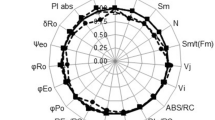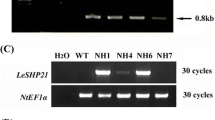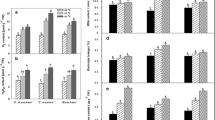Abstract
Tomato ‘Micro-Tom’ plants were transformed for high or low expression of the mitochondrial small “heat shock” protein (HSP) (MT-sHSP23.6) to evaluate their response to high temperature. The plants were raised for 59 days under a controlled temperature, photoperiod and photon flow density and then subjected to heat stress for 24 h at 37 °C, followed by a recovery period under normal conditions (21 ± 2 °C). The cycle was repeated. The chlorophyll a fluorescence intensity was measured, and the parameters of the JIP-test were calculated. The gas exchange was also evaluated. The JIP-test showed significantly different responses of the genotypes to heat stress. The parameters of photosystem I activity and the net assimilation of CO2 increased during the first stress cycle in genotypes with a high expression of MT-sHSP23.6 and in non-transformed plants; however, the net assimilation of CO2 decreased in genotypes with a low expression of MT-sHSP23.6. The data suggest that MT-sHSP23.6 participates in the heat tolerance mechanism, considering that the suppression of this protein resulted in greater physiological damage during heat stress.





Similar content being viewed by others
Abbreviations
- ABS/RC:
-
Absorption flux (of antenna Chls) per RC
- AS:
-
Plants transformed in the anti-sense orientation
- DI0/RC:
-
Dissipation flux per RC
- ET0/RC:
-
Electron transport flux (further than QA−) per RC
- MT-sHSP:
-
Mitochondrial small HSP
- N:
-
Turnover number as reduction, oxidation, re-reduction of QA in time span from light until reaching FM
- OEC:
-
Oxygen evolution complex
- PIABS :
-
Performance index (potential) for energy conservation from exciton to the reduction of intersystem electron acceptors
- PItotal :
-
Performance index (potential) for energy conservation from exciton to the reduction of PSI end acceptors
- PSII:
-
Photosystem II
- PSI:
-
Photosystem I
- RC:
-
Reaction centre
- RE0/RC:
-
Electron flux reducing end electron acceptors at the PSI acceptor side, per RC
- sHSPs:
-
Small HSPs
- S:
-
Plants transformed in the sense orientation
- Sm :
-
Total complementary area normalised above the transient OJIP
- Ss :
-
Total complementary area normalised above the curve of only transient OJ
- TR0/RC:
-
Trapped energy flux (leading to QA reduction) per RC
- WT:
-
Non-transformed plants
- φPo :
-
Maximum quantum yield for primary photochemistry
- φEo :
-
Quantum yield for electron transport (ET)
- φRo :
-
Quantum yield for reduction of end electron acceptors at the PSI acceptor side (RE)
- φDo :
-
Quantum yield for dissipation (DI)
- Ψ0 :
-
Probability (at time 0) that a trapped exciton moves an electron into the electron transport chain beyond QA−
- δ0 :
-
Probability with which an electron from the intersystem electron carriers moves to reduce end electron acceptors at the PSI acceptor side
References
Baker NR (2008) Chlorophyll fluorescence: a probe of photosynthesis in vivo. Annu Rev PlantBiol 59:89–113
Baniwal SK, Bharti K, Chan KY, Fauth M, Ganguli A, Kotak S, Mishra SK, Nover L, Port M, Scharf KD, Tripp J, Weber C, Zielinski D, Koskull-Doring PV (2004) Heat stress response in plants: a complex game with chaperones and more than twenty heat stress transcription factors. J Biosci 29:471–487
Barsan C, Sanchez-Bel P, Rombaldi C, Egea I, Rossignol M, Kuntz M, Zouine M, Latché A, Bouzayen M, Pech JC (2010) Characteristics of the tomato chromoplast revealed by proteomic analysis. J Exp Bot 61:2413–2431
Béthune J, Wieland F, Moelleken J (2006) COPI-mediated transport. J Membr Biol 211:65–69
Bradford MM (1976) A rapid and sensitive method for quantification of microgram quantities of protein utilizing the principle of protein-dye binding. Anal Biochem 72:248–251
Bukhov NG, Sabat SC, Mohanty P (1990) Analysis of chlorophyll a fluorescence changes in weak light in heat treated Amaranthus chloroplasts. Photosynth Res 23:81–87
Bukhov NG, Wiese C, Neimanis SE, Heber U (1999) Heat sensitivity of chloroplasts and leaves: leakage of protons from thylakoids and reversible activation of cyclic electron transport. Photosynth Res 59:81–83
Bukhov NG, Govindachary S, Egorova EA, Joly D, Carpentier R (2003) N, N, N′, N′ -tetramethyl-p-phenylenediamine initiates the appearance of a well-resolved I peak in the kinetics of chlorophyll fluorescence rise in isolated thylakoids. Biochim Biophys Acta 1607:91–96
Camejo D, Rodríguez P, Morales MA, Dell’amico JM, Torrecillas A, Alarcón JJ (2005) High temperature effects on photosynthetic activity of two tomato cultivars with different heat susceptibility. J Plant Physiol 162:281–289
Charng YY, Liu HC, Liu NY, Chi WT, Wang CN, Chang SH, Wang TT (2007) A heat inducible transcription factor, HsfA2, is required for extension of acquired thermotolerance in Arabidopsis. Plant Physiol 143:251–262
Chou M, Chen Y, Lin C (1989) Thermotolerance of isolated mitochondria associated with heat shock proteins. Plant Physiol 89:617–621
Clarke AK, Critchley C (1990) Synthesis of early heat shock proteins in young leaves of barley and sorgum. Plant Physiol 94:567–576
Dubeau SF, Pan F, Tremblay GC, Bradley TM (1998) Thermal shock of salmon in vivo induces the heat shock protein hsp 70 and confers protection against osmotic shock. Aquaculture 168:311–323
Ducruet MH, Lemoine Y (1985) Increased heat sensitivity of the photosynthetic apparatus in triazine-resistant bio types from different plant species. Plant Cell Physiol 26:419–429
Gandia-Herrero F, Lorenz A, Larson T, Graham IA, Bowles DJ, Rylott EL, Bruce NC (2008) Detoxification of the explosive 2,4,6-trinitrotoluene in Arabidopsis- discovery of bifunctional O- and C-glucosyltransferases. Plant J 56:963–974
Hájek T, Honys D, Witters E, Čapková V (2005) Identification of stress-induced mitochondrial proteins in cultured tobacco cells. Physiol Plantarum 124:12–24
Heckathorn SA, Downs CA, Sharkey TD, Coleman JS (1998) The small, methionine-rich chloroplast heat-shock protein protects photosystem II electron transport during heat stress. Plant Physiol 116:439–444
Hoagland D, Arnon DI (1950) The water culture method for growing plants without soil. California agriculture experimental station circular. University of California at Berkeley, Berkeley, p 32
Kouřil R, Ilíka P, Tomeka P, Nauša JAN, Poulíčkováb A (2001) Chlorophyll fluorescence temperature curve on Klebsormidiumflaccidum cultivated at different temperature regimes. J Plant Physiol 158:1131–1136
Lazár D (2006) The Polyphasic chlorophyll a fluorescence rise measured under high intensity of exciting light. Funct Plant Biol 33:9–30
Lee BH, Won SH, Lee HS, Miyao M, Chung WI, Kim IJ, Jo J (2000) Expression of the chloroplast-localized small heat shock protein by oxidative stress in rice. Gene 245:283–290
Lin CY, Roberts JK, Key JL (1984) Acquisition of thermotolerance in soybean seedling, synthesis and accumulation of heat shock proteins and their cellular localization. Plant Physiol 74:152–160
Livak KJ, Schmittgen TD (2001) Analysis of relative gene expression data using real-time quantitative PCR and the 2(-Delta Delta C(T)) method. Methods 25:402–408
Millar AH, Sweetlove LJ, Giege P, Leaver CJ (2001) Analysis of the Arabidopsis mitochondrial proteome. Plant Physiol 127:1711–1727
Millar AH, Trend AE, Heazlewood JL (2004) Changes in the mitochondrial proteome during the anoxia to air transition in rice focus around cytochrome-containing respiratory complexes. J Biol Chem 279:39471–39478
Millar AH, Heazlewood JL, Kristensen BK, Braun HP, Moller IM (2005) The plant mitochondrial proteome. Trends Plant Sci 10:36–43
Millar AH, Small ID, Day DA, Whelan J (2008) Mitochondrial biogenesis and function in Arabidopsis. Arabidopsis Book 6:e0111. doi:10.1199/tab.0111
Misra AN, Srivastava A, Strasser RJ (2001) Utilization of fast chlorophyll a fluorescence technique in assessing the salt/ion sensitivity of mung bean and Brassica seedlings. J Plant Physiol 158:1173–1181
Mohanty P, Kreslavski VD, Klimov VV, Los DA, Mimuro M, Carpentier R, Allakhverdiev SI (2012) Heat stress: susceptibility, recovery and regulation. In: Eaton-Rye JJ, Tripathy BC, Sharkey TD (eds) Photosynthesis: plastid biology, energy conversion and carbon assimilation. Advance in photosynthesis and respiration. v.34. Springer, Dordrecht, pp 251–274
Murakami T, Matsuba S, Funatsuki H, Kawaguchi K, Saruyama H, Tanida M, Sato Y (2004) Overexpression of a small heat shock protein, sHSP17.7, confers both heat tolerance and UV-B resistance to rice plants. Mol Breeding 13:165–175
Nautiyal PC, Shono M (2010) Analysis of the role of mitochondrial and endoplasmic reticulum localized small heat shock proteins in tomato. Biol Plant 54:715–719
Nautiyal PC, Shono M, Egawa Y (2005) Enhanced thermotolerance of the vegetative part of MT-sHSP transgenic tomato line. Sci Hortic 105:393–409
Nishizawa A, Yabuta Y, Yoshida E, Maruta T, Yoshimura K, Shigeoka S (2006) Arabidopsis heat shock transcription factor A2 as a key regulator in response to several types of environmental stress. Plant J 48:535–547
Ogweno J, Song X, Hu W, Shi K, Zhou Y, Yu J (2009) Detached leaves of tomato differ in their photosynthetic physiological response to moderate high and low temperature stress. Sci Hortic 123:17–22
Oukarroum A, Strasser RJ, Schansker G (2012) Heat stress and the photosynthetic electron transport chain of the lichen Parmelinatiliacea (Hoffm.) Ach. in the dry and the wet state: differences and similarities with the heat stress response of higher plants. Photosynth Res 111:303–314
Panda D, Rao DN, Sharma SG, Strasser RJ, Sarkar RK (2006) Submergence effects on rice genotypes during seedling stage: probing of submergence driven changes of photosystem 2 by chlorophyll a fluorescence induction O-J-I-P transients. Photosynthetica 44:69–75
Pegoraro C, Mertz LM, Maia LC, Rombaldi CV, Oliveira AC (2011) Importance of heat shock proteins in maize. J Crop Sci Biotech 14:85–95
Preczewski PJ, Heckathorn SA, Downs CA, Coleman JS (2000) Photosynthetic thermo-tolerance is quantitatively and positively correlated with production of specific heat-shock proteins among nine genotypes of Lycopersicon (tomato). Photosynthetica 38:127–134
Radloff M, Delling M, Gercken G (1998) Protein phosphorylation in alveolar macrophages after stimulation with heavy metal-coated silica particles. Toxicol Lett 96–97:69–75
Rizhsky L, Liang H, Shuman J, Shulaev V, Davletova S, Mittler R (2004) When defense pathways collide. The response of Arabidopsis to a combination of drought and heat stress. Plant Physiol 134:1683–1696
Sanmiya K, Suzuki K, Egawa Y, Shono M (2004) Mitochondrial small heat-shock protein enhances thermotolerance in tobacco plants. FEBS Lett 557:265–268
Schansker G, Tóth SZ, Kovács L, Holzwarth AR, Garab G (2011) Evidence for a fluorescence yield change driven by a light-induced conformational change within photosystem II during the fast chlorophyll a fluorescence rise. Biochim Biophys Acta 1807:1032–1043
Srivastava A, Strasser RJ, Govindjee (1999) Greening of peas: parallel measurements of 77 K emission spectra, OJIP chlorophyll a fluorescence transient, period four oscillation of the initial fluorescence level, delayed light emission, and P700. Photosynthetica 37:365–392
Strasser BJ (1997) Donor side capacity of Photosystem II probed by chlorophyll a fluorescence transients. Photosynth Res 52:147–155
Strasser BJ, Strasser RJ (1995) Measuring fast fluorescence transient to address environmental questions: the JIP-test. In: Mathis P (ed) Photosynthesis: from light to biosphere. Kluwer, Dordrecht, pp 977–980
Strasser RJ, Tsimilli-Michael M, Srivastava A (2004) Analysis of the chlorophyll a fluorescence transient. In: Papageorgiou GC, Govindjee (eds) Chlorophyll fluorescence: a signature of photosynthesis. Advance in photosynthesis and respiration, vol 19. Springer, Dordrecht, pp 321–362
Tsimilli-Michael M, Strasser RJ (2008) In vivo assessment of plants vitality: applications in detecting and evaluating the impact of mycorrhization on host plants. In: Varma A (ed) Mycorrhiza: state of the art, genetics and molecular biology, eco-function, biotechnology, eco-physiology, structure and systematics. Springer, Dordrecht, pp 679–703
Van Aken O, Zhang B, Carrie C, Uggalla V, Paynter E, Giraud E, Whelan J (2009) Defining the mitochondrial stress response in Arabidopsis thaliana. Mol Plant 2:1310–1324
Vierling E (1991) The role of heat shock proteins in plants. Annu Rev Plant Phys 42:579–620
Wahid A, Gelani S, Ashraf M, Foolad MR (2007) Heat tolerance in plants: an overview. Environ Exp Bot 61:199–223
Waters ER, Lee GJ, Vierling E (1996) Evolution, structure and function of the small heat shock proteins in plants. Environ Exp Bot 47:325–338
Yusuf MA, Kumar D, Rajwanshi R, Strasser RJ, Tsimilli-Michael M, Govindjee, Sarin NB (2010) Overexpression of y-totopherol methyl transferase gene in transgenic Brassica juncea plants alleviates abiotic stress: physiological and chlorophyll a fluorescence measurements. Biochim Biophys Acta 1797:1428–1438
Acknowledgments
We acknowledge the financial support of the CNPq (Conselho Nacional de Desenvolvimento Científico e Tecnológico), Ministério de Ciência e Tecnologia, FINEP, CAPES (Coordenação de Aperfeiçoamento de pessoal de Nível Superior), and FAPERGS (Fundação de Amparo à Pesquisa do Estudo do Rio Grande do Sul).
Author information
Authors and Affiliations
Corresponding author
Rights and permissions
About this article
Cite this article
Huther, C.M., Ramm, A., Rombaldi, C.V. et al. Physiological response to heat stress of tomato ‘Micro-Tom’ plants expressing high and low levels of mitochondrial sHSP23.6 protein. Plant Growth Regul 70, 175–185 (2013). https://doi.org/10.1007/s10725-013-9790-y
Received:
Accepted:
Published:
Issue Date:
DOI: https://doi.org/10.1007/s10725-013-9790-y




